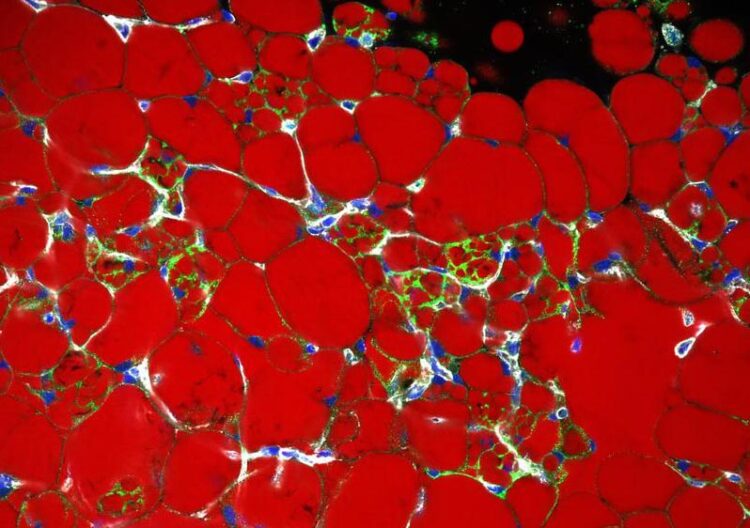New approach for the development of a drug treatment for obesity and the resulting diseas

Beige adipocytes in white adipose tissue. (Beige adipocytes with UCP-1 stained in green. Lipids are red and F-actin, which outlines the cells and especially the blood vessels, is gray, DNA is blue).
Bild: Ruth Karlina
The protein Asc-1 regulates whether fat-burning beige or fat-storing white adipocytes are formed, which can have an impact on the development of metabolic diseases. This is shown by a current study of the Helmholtz Zentrum München and the German Center for Diabetes Research (DZD). The results open up new approaches to prevent the development of metabolic diseases. The study has now been published in Nature Communications.
Not all fat is the same: there is white, brown and beige adipose tissue *. While white fat cells serve as energy stores, excess energy is burned in brown and beige fat tissue. Too much white fat is considered unhealthy. If the white adipose tissue increases significantly in adults with obesity, metabolic diseases such as diabetes or metabolic syndrome can develop. The situation is different in children: There, the initial formation of white adipose tissue is a prerequisite for a healthy metabolism. But how does adolescent adipose tissue differs from adult white adipose tissue? To answer this question, researchers have investigated the composition of white adipose tissue of young and adult mice using single cell RNA sequencing**.
Asc-1 promotes the formation of white adipocytes
The researchers found that adolescent adipose tissue differs greatly from adult white fat, especially in terms of the properties and composition of fat precursor cells. The researchers discovered a special subgroup of fat precursor cells in adolescent adipose tissue that contain the protein Asc-1, which is otherwise present in mature adipocytes. These precursor cells differentiate predominantly into white adipocytes, and the formation of “healthy” beige adipocytes is actively suppressed. In further cell biological investigations, the team around first author Lisa Suwandhi were able to show that the loss of Asc-1 function promotes the formation of beige adipocytes.
“These insights into the physiological processes of adipose tissue growth enable us to develop new strategies to prevent the harmful metabolic consequences of obesity,” said last author Dr. Siegfried Ussar. The researchers are already pursuing this approach further. They are currently establishing strategies to modulate Asc-1 function in adipose tissue in the living organism and exploring ways to promote healthy adipose tissue expansion. The goal is to help obese patients maintain a healthy metabolism in the future and thus gain time to treat obesity with a holistic approach.
* Adipose tissue
There are different types of adipose tissue: white, brown and beige. Each of these tissues has specific functions and each plays its own role in the metabolism. In the human body, white adipose tissue represents the largest proportion. It serves primarily as an energy store. Cells of the brown adipose tissue are rich in mitochondria (power plants of the cell). They burn free fatty acids and thus generate heat. Babies in particular have brown adipose tissue. In the adult human body, however, it is only found in a few places. Beige adipocytes develop within the white adipose tissue. However, they are similar to brown adipocytes in their ability to burn excess energy. They are an interesting target for the development of new drug therapies to treat obesity and the resulting diseases such as type 2 diabetes.
** Single-cell RNA sequencing
In simple terms, single-cell RNA sequencing can be used to trace which genes are currently switched on or off in a single cell.
Wissenschaftliche Ansprechpartner:
Dr. Siegfried Ussar
Helmholtz Zentrum München
Ingolstädter Landstraße 1
D-85764 Neuherberg
E-Mail: siegfried.ussar@helmholtz-muenchen.de
Phone: +49 89 3187-2047
Originalpublikation:
Suwandhi L, Altun I, et al.: Asc-1 regulates white versus beige adipocyte fate in a subcutaneous stromal cell population. Nat Commun. 2021 Mar 11;12(1):1588. doi: 10.1038/s41467-021-21826-9
https://www.nature.com/articles/s41467-021-21826-9
Media Contact
All latest news from the category: Life Sciences and Chemistry
Articles and reports from the Life Sciences and chemistry area deal with applied and basic research into modern biology, chemistry and human medicine.
Valuable information can be found on a range of life sciences fields including bacteriology, biochemistry, bionics, bioinformatics, biophysics, biotechnology, genetics, geobotany, human biology, marine biology, microbiology, molecular biology, cellular biology, zoology, bioinorganic chemistry, microchemistry and environmental chemistry.
Newest articles

Pinpointing hydrogen isotopes in titanium hydride nanofilms
Although it is the smallest and lightest atom, hydrogen can have a big impact by infiltrating other materials and affecting their properties, such as superconductivity and metal-insulator-transitions. Now, researchers from…

A new way of entangling light and sound
For a wide variety of emerging quantum technologies, such as secure quantum communications and quantum computing, quantum entanglement is a prerequisite. Scientists at the Max-Planck-Institute for the Science of Light…

Telescope for NASA’s Roman Mission complete, delivered to Goddard
NASA’s Nancy Grace Roman Space Telescope is one giant step closer to unlocking the mysteries of the universe. The mission has now received its final major delivery: the Optical Telescope…



